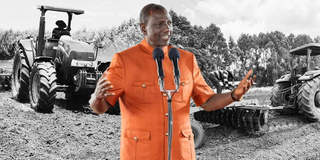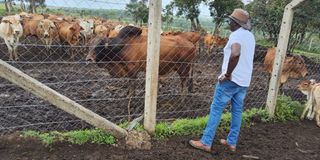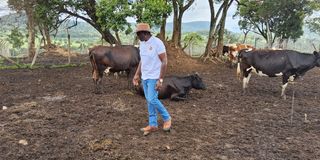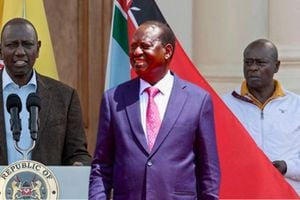
President William Ruto is slowly transforming his home in Kilgoris, Narok County, into a new centre of power.
For 24 years, former president Daniel arap Moi's sprawling 2,300-acre Kabarak home in Nakuru was the citadel of his power and the heart of Kenyan politics.
During his reign, Kabarak became a sanctuary where Moi could escape the political pressures of Nairobi, make and break careers and extend his legendary generosity.
Fast forward to 2024 and President William Ruto, a political disciple of Moi's, is developing a similar affinity for his home in Kilgoris, Narok County, and slowly transforming it into a new power centre.

President William Ruto at his farm in Kilgoris.
President Ruto, like Moi before him, often retreats to his Narok home, especially on weekends, to make key decisions for the country.
Over the past year, the head of state has been seen touring his sprawling 900-acre farm to check on his cattle or hold important meetings. He also attends local church services in the area on Sundays.
For instance, in the midst of the Gen Z-led protests on June 30, Dr Ruto addressed the youth of Lolgorian PEFA Church, urging dialogue. The latest was on August 4, when he attended another church service in Kilgoris, accompanied by Narok Governor Patrick Ntutu and other local leaders.
In March 2024, he also attended a church service in Kilgoris where he urged politicians, elders and church leaders to sit down and find a lasting solution to the raging inter-clan clashes in Trans Mara.
Another notable event was on March 30, when the President chaired a high-level security meeting at his home in Trans Mara to address the security situation in the North Rift region.
The meeting was attended by then Cabinet Secretary for Interior Prof Kithure Kindiki, Principal Secretary for Interior Raymond Omolo, former Inspector General of Police Japhet Koome, Rift Valley Regional Coordinator Abdi Hassan and former Rift Valley Police boss Tom Odero.
Photos of the meeting shared on social media showed the lush green expanse of Dr Ruto's home.
But the President's connection to his home in Narok goes beyond politics.
In May 2024, photos of Dr Ruto and First Lady Rachel Ruto inspecting their wheat farm and planting trees were shared online by the president's communications team, highlighting the president's personal investment in the property.
Political analysts say Ruto's Narok home is becoming a centre of power, similar to Moi's Kabarak.
Lawyer and political analyst Steve Kabita notes that his frequent visits and important meetings at the Trans Mara home underscore its growing importance.
"President Ruto frequently visits his Trans Mara home, he has held many important meetings there and it is becoming a hideaway where he retreats to when there is pressure in the capital Nairobi to make important decisions about the country," says lawyer Kabita.

President William Ruto at his farm in Kilgoris.
Locals who spoke to Nation describe the president as a friendly neighbour.
Mr Thomas Sankale, a resident of Lolgorian, expressed pride in having the President as a neighbour and appreciated his interactions despite the tight security.
He also expects more development because of Ruto's presence.
"In fact, we usually attend the same church when he is in Trans Mara, he is a great man, anyone can wish to have as a neighbour, despite the tight security that usually accompanies the Head of State, he always finds time to interact with us," Mr Sankale revealed.
The 35-room palatial home is situated on a 900-acre ranch, which was purchased from former Vice-President Joseph Murumbi in 2015.
The president has transformed the once dilapidated ranch into an opulent estate, complete with hundreds of cattle and supervised farming.
Narok County, like neighbouring Nakuru, is now home to more than one president.
Former President Uhuru Kenyatta has a 1,000-acre ranch nearby, while Nakuru is home to former presidential residences, including Moi's Kabarak and Kenyatta's Gicheha Farm, known for its extensive agricultural investments.
The 4,000-acre farm is located one kilometre off the Nakuru-Eldoret highway and has over 1,000 animals and several plantations.
Uhuru has bred exotic animals exported from South Africa and Uganda.
These include; Boer goats, Brangus, Charolais, Hereford, Brahman and Ankole cows. Local breeds include the Boran and Sahiwal cattle.
The farm has also recently imported 42 Boer goats from South Africa, which are bred for milk.
Retired President Mwai Kibaki also had a home in Bahati Sub-county, which he rarely visited.
The late Mzee Moi had seven known private homes - one in the capital, Nairobi, and six in the Rift Valley.
Of the seven, only two - Kabarnet Gardens near Nairobi's Kibera slums and Kabarak Farm in Rongai near Nakuru town - are well known.
He acquired the Kabarak home during his time as Vice President in the 1970s, years before he took over as President from Kenya's founding father, Mzee Jomo Kenyatta, following his death on August 22, 1978.









